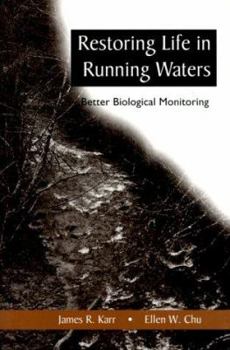Restoring Life in Running Waters: Better Biological Monitoring
Despite nearly three decades of efforts intended to protect the nation's waters, and some success against certain forms of chemical and organic contamination, many of our nation's waterways continue... This description may be from another edition of this product.
Format:Paperback
Language:English
ISBN:1559636742
ISBN13:9781559636742
Release Date:November 1998
Publisher:Island Press
Length:220 Pages
Weight:0.75 lbs.
Dimensions:0.9" x 6.0" x 9.0"
Customer Reviews
4 ratings
Invaluable for those concerned about fish habitat
Published by Thriftbooks.com User , 24 years ago
This book provides a functional, usable set of guidelines to consider when working on fisheries habitat and stream rehabilitation problems. Although it is oriented towards the American environmental processes - EPA etc, the background concepts and information should be required reading for everyone who is involved in both environmental monitoring and assessment, and those who are involved in trying to bring back stream habitat that has been lost.Useful for a much broader audience than originally targetted. For instance Community Stewardship groups here in BC have found it most useful.
Informative, thorough, and interesting
Published by Thriftbooks.com User , 25 years ago
A very informative, thorough, and interesting coverage of the topic. Very well written and an enjoyable read. I especially liked the presentation of the "chapters" as "premises."Advocacy is one theme of this book, but I didn't find that objectionable. As a former professional in the regulatory field, I think it is important for people with opinions to express them! This book is really a must-read for people working on any aspect of biological monitoring of aquatic systems.
Excellent strategy & advice; slightly one-dimensional
Published by Thriftbooks.com User , 26 years ago
Karr & Chu provide compelling arguments for the inclusion of reasoned biomonitoring efforts in Environmental Impact Assessment (EIA) of aquatic ecosystems. This is long-overdue. Their desire for biological relevance above and beyond statistical significance is also laudable, reminding me of a dear mentor's constant advice: "But what do the numbers *mean* biologically??" It is an extremely well documented book as well, providing ample resources for further scholarly investigation of related topics. I laud their eagerness to create biological relevance and move beyond standard statistical distributions by brute biological common sense. Their approach is clearly robust, time-effective, and biologically relevant - an excellent combination for real-world environmental management decisions! I do, however, find the authors' quite one-dimensional focus on the use of single "multimetric indices" to be limiting in the practice of aquatic EIA. (Multimetric indices are sums of individual indices, each measuring a different ecological factor.) I fear that the same mathematical machinations which make Karr & Chu's methods robust may also make them insensitive to subtle biological changes. They might contend that robust management considerations render subtle biological changes irrelevant; I would argue that subtle change over time can be at least as powerful as quantum, near-instantaneous changes. The author's methods are also constrained by the fact that the a significant effort is expended in calibration, which may be fine and justified for future studies, but may be of little help for projects currently "in-hand." In conclusion, I would definitely recommend this book as a required read in aquatic biomonitoring strategies, but I will continue to examine my data in more statistically conventional ways as well as through multimetric indices --- I'm not likely to throw out the entire old toolbox for the addition of one new tool, after all, and all the multimetric indices in the world won't do a jot of good without sound experimental design practices.
Thoughtful and inspiring yet a bit too one dimensional
Published by Thriftbooks.com User , 26 years ago
Karr & Chu write to inspire improvement in biological assesment protocols; no doubut I agree with them on this goal. They also remind us all that the "proof of the pudding" is in the biological relevance of the statistical analyses which we undertake to perform this task. Again, no problem. I do have suspicions re: their rather singular fixation on univariate compression of data to the IBI format to the extent that any & all multivariate data treatments are avoided. I would strongly recommend this text as a starting point, but would equally strongly recommend that you *avoid* considering it a definitive Bible for these assessment processes. An apt ecologist who is conversant with contemporary techniques of biotic quantification should perhaps be able to come up with some more multivariate and flexible metrics in addition to those suggested in this text -- although their tables of "what works where" are very helpful starting guidlines for pragmatic issues of what variables to measure in the field. Excellent documentation if you want to go after the references found in the bibliography. Wonderfully aggresive attitude re: preserving our rivers & engaging style -- I read most of the book this afternoon just because it's so engaging, which is pretty high praise for a textbook. If you also happen to be involved with biomonitoring efforts, please drop me an email as I'm working remotely via the 'Net & wold love the comraderie & discussion -- Eric entfolks@mwci.net





